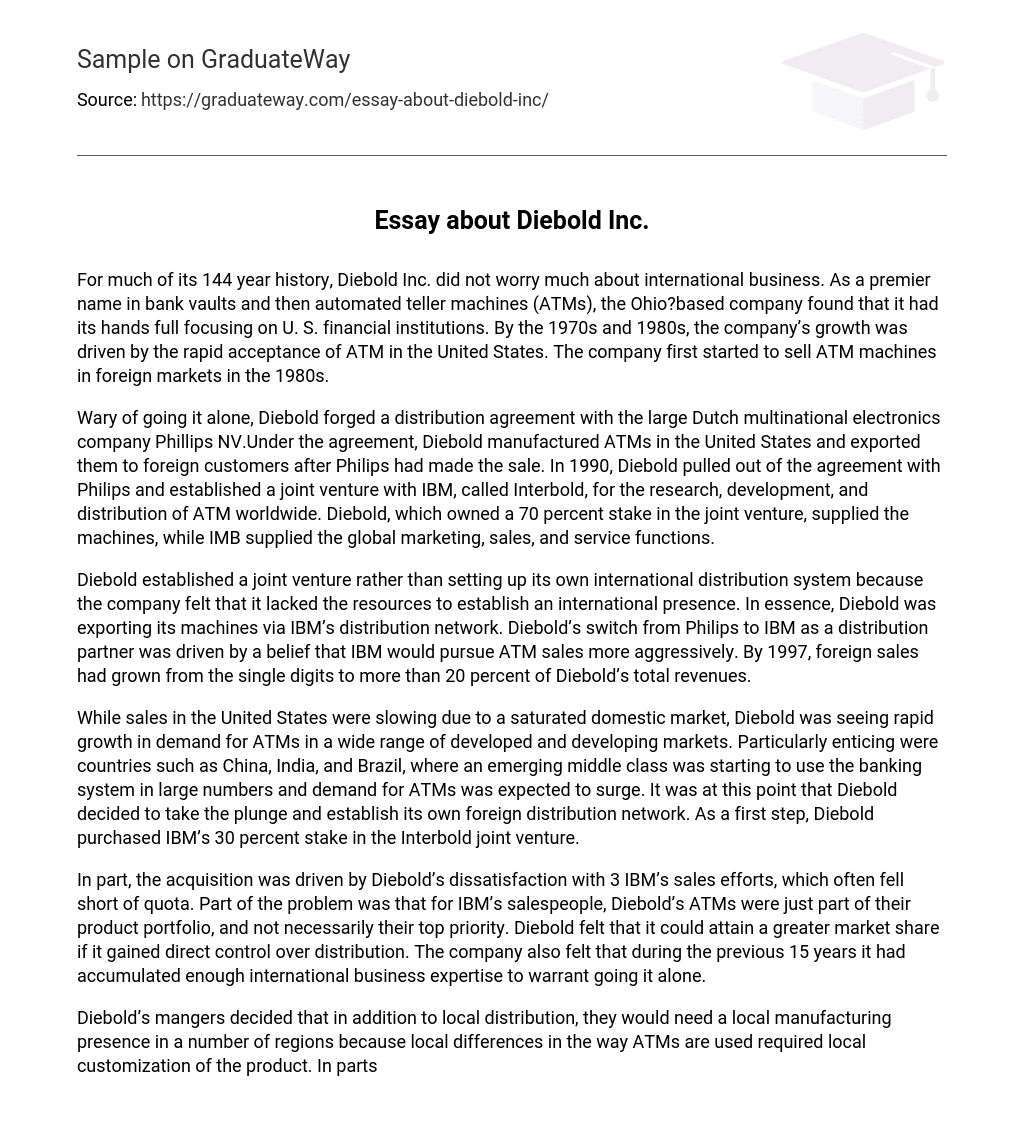Diebold Inc. primarily focused on domestic business operations for a considerable period of time, specifically serving U.S. financial institutions with its renowned bank vaults and subsequent automated teller machines (ATMs). The company witnessed substantial growth during the 1970s and 1980s as ATMs became widely adopted within the United States. It was not until the 1980s that Diebold started entering foreign markets by selling ATM machines.
Diebold entered into a distribution agreement with Phillips NV, a Dutch multinational electronics company, to manufacture and export ATMs. Later, in 1990, Diebold ended the agreement and formed a joint venture with IBM called Interbold. This joint venture was responsible for the research, development, and distribution of ATMs worldwide. Diebold held a 70 percent stake in the joint venture and provided the machines, while IBM handled global marketing, sales, and service functions.
Diebold chose to form a joint venture instead of creating its own global distribution system due to a perceived lack of resources for establishing an international presence. Essentially, Diebold utilized IBM’s distribution network to export its machines. The decision to shift from Philips to IBM as a distribution partner was motivated by the expectation that IBM would be more proactive in pursuing ATM sales. By 1997, sales in foreign markets had expanded from single digits to over 20% of Diebold’s total revenues.
In the United States, sales were decreasing because of market saturation. Nevertheless, Diebold was seeing substantial growth in demand for ATMs in different developed and developing markets. This pattern was especially noticeable in countries such as China, India, and Brazil where an expanding middle class was progressively utilizing the banking system and generating a greater requirement for ATMs. It was at this juncture that Diebold made the decision to establish its own foreign distribution network by acquiring IBM’s 30 percent share in the Interbold joint venture.
Diebold acquired IBM due to their dissatisfaction with IBM’s sales efforts, which frequently failed to meet targets. One of the issues was that Diebold’s ATMs were not a top priority for IBM’s salespeople since they had a wide range of products to focus on. Diebold believed that by taking direct control over distribution, it could increase its market share. Additionally, after accumulating significant international business expertise over the past 15 years, Diebold felt confident in going forward independently.
Diebold’s managers made the decision to establish manufacturing facilities in various regions, in addition to distributing their products locally. This was necessary due to the unique ways ATMs are utilized in different areas, which required customizing the product to meet local needs. For instance, in some parts of Asia, customers use ATMs to pay their utility bills with cash. To capture a larger market share, Diebold had to develop ATMs that could accept and accurately count stacks of up to 100 currency notes, while also detecting counterfeit bills. In other countries, ATMs perform diverse functions such as processing tax returns and distributing theatre tickets.
Diebold’s strategy was to establish manufacturing facilities near important markets in order to streamline customization and enhance sales. To accelerate its global expansion, Diebold embarked on an aggressive acquisition spree. In 1999, Diebold acquired Procomp Amazonia Industria Electronica in Brazil, a prominent Latin American electronics company generating $400 million in sales and dominating the ATM industry. Following this successful acquisition, Diebold swiftly purchased the ATM divisions of Group Bull in France and Getronics in Holland. Both of these companies were prominent players in Europe, making the combined cost for these acquisitions $160 million.
In China, Diebold established a manufacturing and distribution joint venture, where it held the majority ownership due to the absence of significant local competitors for acquisition. By 2002, Diebold had manufacturing facilities in Asia, Europe, Latin America, and the United States. Additionally, they operated distribution operations in around 80 countries, with most being fully owned by Diebold. In 2003, international sales accounted for approximately 41 percent of the company’s $2.1 billion in revenues. It was anticipated that these sales would continue to expand at double-digit rates.
Diebold’s purchase of Procomp in Brazil presented the company with fresh prospects. Not only did Procomp excel in ATM operations, it also possessed a thriving division specializing in electronic voting machines. In fact, Diebold and Procomp inked a historic agreement worth $105 million in 1999, which marked the largest contract ever for Diebold. The deal aimed to provide Brazilian polling stations with electronic voting terminals. This pivotal partnership made Diebold’s leadership recognize the immense potential for a profitable global enterprise within this industry.
Diebold expanded its electronic voting business in 2001 when it acquired Global Election Systems Inc., an American company specializing in electronic voting technology for state and countries looking to modernize their voting systems.
According to the source, by 2003, Diebold had become the top player in the growing global market for electronic voting machines, achieving sales exceeding $100 million.
The source of the text is a book titled “International business: Competing in the global marketplace (6th ed.)” published in 2007 by McGraw-Hill in New York.The text that follows is on page 506.





